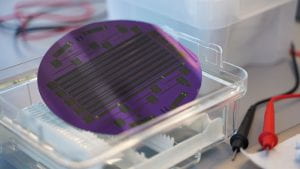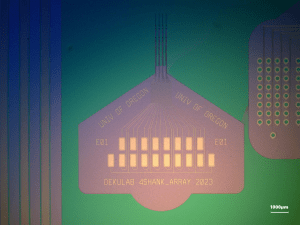Research Projects
Flexible microelectrode array fabrication and packaging:
The lab develops microfabrication techniques to construct micrometer-scale thin-film devices for neural interfacing. We primarily use the new state-of-the-art microfabrication manufacturing facility at the Knight Campus for our device development. We are currently developing high-density, multi-shank, intracortical microelectrode arrays featuring amorphous silicon carbide thin-films. We are actively investigating how microelectrode array design and fabrication methods impact device stability over long-term use. We are also interested in exploring how device geometry influences insertion of microelectrode arrays into neural tissue. Additionally, the lab investigates interconnection and packaging strategies to facilitate the development of a multi-site high density (1000+ channel) neural probe.
Thin-film materials engineering and characterization:
The lab explores semiconductor deposition techniques such as plasma-enhanced chemical vapor deposition (PECVD) and physical vapor deposition (PVD) to deposit thin layers of ceramics and metals with tunable physical and chemical properties. We study the effect of the deposition conditions on the mechanical, optical, and chemical behavior of these films — including stability, surface morphology, and overall influence on tissue integration. We also explore specialized chemical vapor deposition methods such as atomic layer depositions (ALD). Films are characterized using scanning electron microscopy (SEM), atomic force microscopy (AFM), ellipsometry, Fourier transform infrared spectroscopy (FTIR) x-ray photoelectron spectroscopy (XPS), and electrochemical measurement techniques. The lab is also interested in investigating electrodeposition methods for creating stable electrode coatings of conductive polymers and metal oxides with high electrochemically active surface area for neural stimulation and recording.
Safety and efficacy studies in animal models:
The lab currently investigates the performance of our custom-built neural recording microelectrode arrays in a rodent model. The lab also investigates the physiological effects of neural stimulation in several brain regions, including cortical and deep brain areas, using a rodent model. We also investigate the effects of stimulating in single versus multiple target regions in closed-loop and open-loop configurations.



